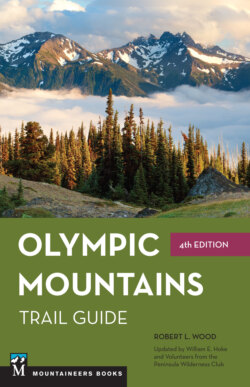Читать книгу Olympic Mountains Trail Guide - Robert Wood - Страница 27
На сайте Литреса книга снята с продажи.
THE SEASONS
ОглавлениеMost of the hikers and backpackers who go to the Olympic Mountains do so during the warm months, from May through September, when the days are long because of the high latitude. But to really know the Olympics, one must visit them throughout the year because they have moods that vary with the changing seasons. Viewing the peaks when they are softened by summer haze is not enough, because they are equally interesting when shrouded in autumn’s fog banks and winter’s mists, or during the springtime, when they hide behind dark, wind-driven clouds.
Spring comes early to the lowlands, arriving in April when the dogwoods splash white against the evergreens, and climbs the mountainsides as the snow line recedes, to culminate at higher elevations when the rhododendrons blossom in early July. This season is uncertain and tentative in the Olympics, with damp, chilly weather, and fog lingering in the deep canyons. A noisy time, it contrasts vividly with the white silence of winter and the lazy somnolence of summer. The squawking of the ravens and jays and the booming of streams that carry the melting snow to the sea are accented by the rumble of avalanches. In the lowlands the forest comes alive, exhibiting many shades of green.
Camping in the high alpine near Marmot Pass (Hike 82)
Spring fades into the lovely summer, which is brief in the high country—a succession of sunny days, cool in the morning, warm in the afternoons. Clouds often gather during the day, when cumulus masses float around the higher peaks, only to dissipate with the approach of night. Occasionally they develop into thunderheads accompanied by lightning and heavy showers, but this is unusual.
The balmy days of autumn, known as Indian summer, add a delightful touch to the close of summer, and with regard to pleasant hiking weather, the Olympics are at their best during this season. This is a beautiful time in the high country, often heralded by a definite chill in the air. The days are warm, seldom hot, with an abundance of sunshine mellowed by cool breezes. The atmosphere has an almost indescribable quality—an essence akin, perhaps, to that of an exotic wine, intensified by the stillness, the buzzing of bees, the murmur of distant brooks. The vagrant winds rustle the brown grasses and remind one that winter is lurking in the wings, soon to rush onstage.
Down in the lowland forests the maples turn scarlet and gold, brilliant against the dark green of the conifers, and the slim trunks of the alders stand starkly white beside the streams. On high, exposed meadows huckleberry bushes glow like purple beacons, and the hiker is likely to see bears gorging on the fruit. Nights become longer and crisper, and the stage is set for snowfall when the first storms arrive.
At this time of year the sun dips behind the western ridges early, and the nights are cold enough to kill most of the insects; thus one may not have to contend with mosquitoes, flies, gnats, and yellow jackets. The fish are hungry because they have few bugs upon which to feed. Consequently, anglers are usually successful during this season. On cloudless nights the stars shine brightly above the dark silhouettes of the mountains, heavy frost sparkles on the grass and heather, and before dawn skims of ice edge the pools and lakes.
Backpackers who delight in hiking through the high country at this season should bear in mind that the days are shorter than they are in midsummer, and that darkness arrives early. They should also be prepared for lengthy sessions in their sleeping bags. Not only are the nights longer, they are also colder, and the chilly morning air is not conducive to early rising. Well-equipped hikers illuminate their tents with candle lanterns and have reading material available. They also take plenty of warm clothes. They will meet fewer people on the trails—in fact, at times no one—and thus are strictly on their own and should be prepared to cope with sudden storms, which might leave the trail covered with snow.
The Olympics are not blessed with Indian summer every year, and sometimes the high country undergoes a sudden transition from summer to winter. Usually, however, one can expect several weeks of fine autumn weather, perhaps broken now and then by an early storm. In fact, during this seasonal transition the weather pattern is variable and changes quickly. One day the skies are sunny, the air redolent with the odors of fall; the next, the sun has disappeared and ragged clouds scud across the skies, trailing rain as they move inland.
Snow usually begins to fall in the high country in October, the autumn storms drenching the lowlands with rain and whitening the peaks and ridges left barren by the summer sun. Although the snow often melts on warm succeeding days, especially on exposed southern slopes, this frosting of the mountaintops signals the approach of winter, when gray clouds roll in relentlessly from the Pacific, releasing heavy rain on the lowlands and snow at the higher elevations. As the weather becomes colder, the snow line descends the mountainsides. The high peaks now stand isolated, seldom disturbed by humans. On clear mornings the peaks appear to have been chiseled from marble; thus they contrast vividly with the green forests and the blue skies. But during the storms, when the wind howls through the canyons, the peaks are hidden behind a veil of clouds.
The snowpack usually reaches its maximum depth in late winter. On the windward side of the mountains, this may be 30 to 40 feet on the higher peaks, an accumulation that leads to heavy avalanches in the springtime.
